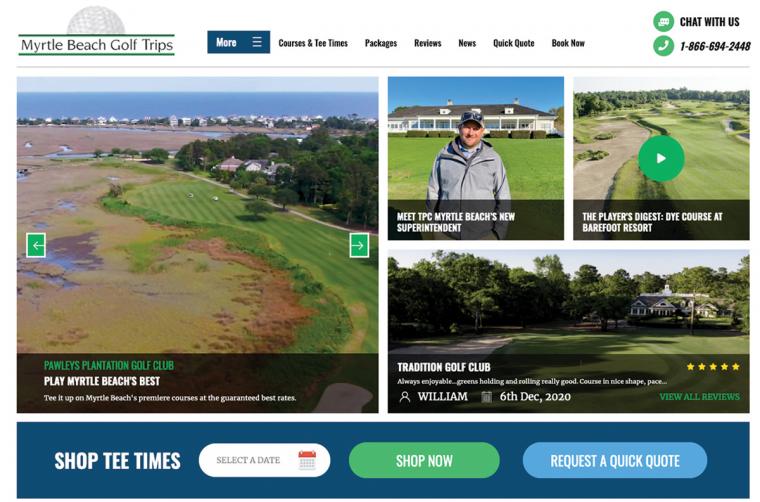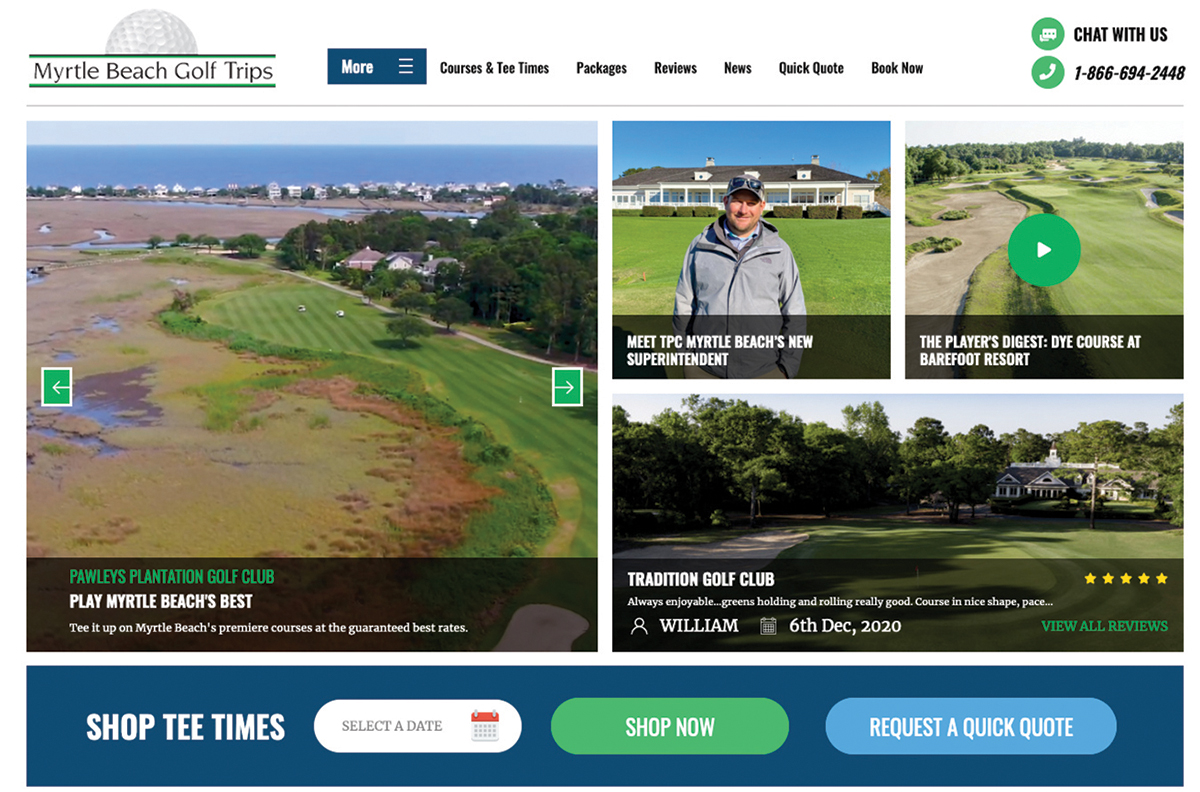

Knowing Our Goals
Being here in Myrtle Beach, one of the country’s top golf destinations, we naturally wanted to encourage visitors not just to use our courses but to stay a few days and enjoy all the area offers. We knew that we wanted to have an interactive site people could visit and not only learn about the courses but book tee times, make reservations for lodging and basically plan their whole trip. Ultimately, we wanted this website to be the number-one resource for golf in Myrtle Beach.
We had evaluated our old site and decided it was outdated. It was cumbersome and hard to use, and a visitor wasn’t likely to be impressed by it. And ultimately, if someone comes to your site and they can’t immediately find what they’re looking for, you’re going to lose them. We didn’t want that to happen.
Laying the Groundwork
A year and a half ago, we actually went into the planning stages for the site. That may seem like a lot of time but the whole planning process is key to getting what you want. While everyone wants to see the finished product, what’s often overlooked is the amount of work that needs to go into it beforehand. In fact, it’s safe to say you’re not aware of the amount of work that is going to be involved until you dive into it. For us, it was a lot of sit-down meetings with our marketing team – and those were really vital because it was where we were able to talk about our ideas and our goals and how we wanted to accomplish them.
One of the best ways for us to decide what the website needed to have was to put ourselves into the role of the customer who would go online, potentially looking to book a tee time or even plan a golf vacation. What did they want? What did they need? What kind of content would they appreciate and how could we make it easy for them to plan their trip using that website? Sometimes, you need to think not as much about what you know but about what your customer wants to know.
We thought it was important for the site to reflect the reality that we live in the information age. As a result, we decided one part of our content should be devoted to social media (we have Instagram, Twitter and Facebook accounts) and that the site should also feature reviews of courses from actual visitors. We also carry news, such as the fact that nine Myrtle Beach courses were ranked on Golfweek’s list of “Top 200 Golf Resorts in the U.S.” There is a section on golf tips and instruction as well. There is a mechanism for them to be able to check prices and immediately book tee times online.
Something else we wanted was accessibility. Anyone who comes to the website should be able to get the information they want or the answers they need. If they can’t find it on the website right away, we wanted to make sure they had a way to reach us so that we could get them those answers. As a result, users can now contact us through our 800-number or our chat feature.
In many cases, people are looking for something specific, such as a condo on the beach with a certain number of bedrooms or a hotel with specific amenities. If they can’t find exactly the answer they want from the site, they can contact us by calling or chatting, or they can use our “Get a Quote” form to state exactly what they want. We have very quick response times because we know that’s what people need.
Another way the site is helpful is when we have inquiries from people who want to host golf tournaments in Myrtle Beach. We can have one-on-one conversations with the tournament director and drill down to find out exactly what they’re looking for and the kind of options we can offer them. They can let us know how many players they expect to bring, any specific courses they’re interested in or hotels where they want to stay, and our agents and golf directors can customize an event for them.
Gathering Ideas
“Making our website better” might be the ultimate goal but it didn’t really give us much of a start. We spent a lot of time examining sites, checking out other destinations and doing our research. That way, we had concrete examples of what we liked as far as elements of design, navigation and functionality.
That sort of research can help your website designer provide you with an accurate estimate for doing the work. (And ultimately, you want to try to get these ideas ironed out in the beginning because once you have a vendor and they have given you a price, you don’t want people coming in and saying, “Hey, I have a good idea for the site” or “Wouldn’t it be cool if we had…?” because that adds to your costs).
Deciding on a Vendor
Once we had a good idea of the elements we wanted and we had a good idea of what we wanted to spend, we solicited bids from web design companies who were interested in doing the kind of work we needed. In the end, we decided to work with a company that had handled our accounts previously. We knew they would listen to us and find out what we wanted; they weren’t going to try to dictate to us what they thought we should have.
That last part was especially important to us because we knew exactly what we wanted to showcase; an outside company might not necessarily understand what we’re all about. We wanted people to come to our site and decide they want to play golf here and then we wanted to make it easy for them to do that. The company we selected understood what we wanted and helped us accomplish that.
Another part of working on the site, and one that was vital to its success, was SEO. It’s not enough just to have a great website; you need search engines to pick it up. That means putting in a lot of work on the back end. It’s easy to lose sight of this because to people who just use a website to look up what they need or want (and who are not really tech-savvy), SEO is invisible. Having all the right keywords, however, puts your site higher in the search rankings. And, as we have now learned, when you update your site, you have to update the keywords as well. I honestly recommend outsourcing this work to a company that specializes in it. We worked hand-in-hand with our SEO company and it really paid off.
Make the Investment
Sometimes, it surprises people that there is such a significant outlay of money when it comes to web design. However, you need to spend money to make money. The site redesign, for us, will happen about once every six years. It’s an investment but it’s a crucial one. Have a fair budget in mind when you go down the path of producing a website. Remember that everyone is doing their searches online, either at their desk or on their phone. You want them to be able to find you and you need the site to look good on whatever device they are using.
Be aware as well that it’s a significant investment of time. That’s something we can really attest to. When you have a transactional site (like ours, where you can book tee times and make reservations at any number of different locations), there are a lot of pieces that need to come together. Our marketing team was very good at helping us connect all the dots, but it still took quite a bit of time.
Before the new site went live, we had to do extensive testing on it to make sure it all worked. Things can (and do) go wrong, so you need to have a lot of patience and put in all the time you need while you’re still working in the beta version. Designing the site is rewarding but it’s also very strenuous.
The Results
The all-new, interactive website went live in the beginning of September 2020 and the reception to it was overwhelmingly positive. Almost immediately, we saw an increase in tee times being booked and in people making arrangements for golf trips – which was exactly what we wanted to accomplish. We have been seeing new visitors come to the site, so we know it’s coming up on the search engines. The analytics are very strong.
The site is visually appealing. It has all the content golfers want – course descriptions and photos, user reviews, pro tips, package deals, information on accommodations, news, even information on restaurants in the area. Those who want to book tee times can sort by price, time of day and location. It showcases the destination perfectly and makes it easy for people not only to learn more but to come here.
Developing a new site has been time-consuming but fun. We were able to mold the site the way we wanted and to create something we were really proud of. For those who are thinking of heading down the same road, the best advice I can give is this: be prepared. Before you ever meet with potential vendors, put in the time to meet with your team to answer the following questions:
• What overall impression do we want our site to make?
• What do we want it to accomplish?
• What do I want visitors to my site to see – photos, videos, etc.?
• What kind of content are visitors to our site looking for?
• What do I want those visitors to do as a result of what they’ve seen here?
• How can we make it possible/easy for them to do that?
• How will they be able to contact us?
• How quickly can we respond to their inquiries?
These are just a few basic questions but having the answers to them can help you decide upon your goals for the website. In the discussions you have moving forward, you’ll always want to keep those goals top of mind. As you work with your team to develop a new site, you want to stay focused on the goals. Don’t get sidetracked. Remember that it’s a step-by-step process and it will not (and should not) happen quickly. You’re essentially creating a whole new you. SDM

